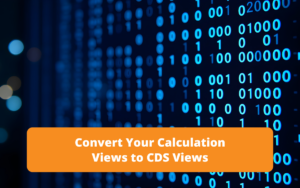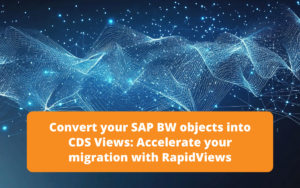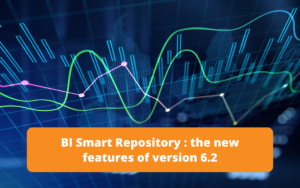What is SAP Datasphere?
On 8 March 2023 SAP launched SAP Datasphere, the successor to SAP Data Warehouse Cloud. SAP Datasphere is part of the new generation of Data Warehouse in the cloud. In addition to the name change, this new version of the Data Warehouse introduced by SAP promises a number of new features.
SAP Datasphere is a cloud-based data warehouse solution that uniquely harmonises organisations’ strategic data. With the aim of facilitating and accelerating decision-making, SAP Datasphere is a tool designed for both experts from the world of analytics and key business users. In terms of interfaces, the duality between technical and business users is reflected in the ‘Data Builder’ layer, dedicated to integration and modelling, and the ‘Business Builder’ layer, dedicated to semantics and business rules.
To give even greater meaning and intelligence to data, SAP is introducing data cataloguing functionalities, which make it possible to define, rationalise and centralise the Analytics objects in a customer repository, from reports to KPIs.
On the reporting side, SAP Datasphere is more integrated than ever with SAP Analytics Cloud, SAP’s cloud reporting solution. New functionalities offered by SAP Datasphere significantly optimise the user experience.
Finally, SAP Datasphere continues to integrate SAP and non-SAP data (Google, Oracle, Amazo, etc.).
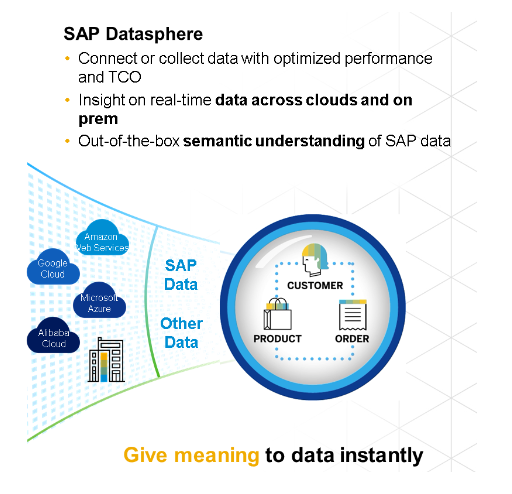
SAP Datasphere
Subscribe to the Rapid Views Newsletter !
Stay up to date with our latest blog posts, upcoming webinars and news!
SAP Datasphere Architecture
SAP has retained all of the functionality of SAP Data Warehouse Cloud (SAP DWC), while adding new functionality that improves the discovery, modelling and distribution of enterprise data. This evolution has had no impact on the workload of SAP DWC customers. The update is performed automatically, so no migration is required. This will be the case for all new functionalities
Accessing and using diverse data from different information systems and locations such as cloud providers, on-premise systems and different data sources has always been a complex challenge for organisations. The processing that this data undergoes in order to centralise it and return it afterwards (extraction, transformation, export, etc.) leads to the loss of its business context. SAP Datatsphere gives its customers the benefit of an enterprise data fabric architecture that harmonises critical data (SAP and non-SAP) in a single way and rapidly delivers meaningful data with business context and logic.
SAP Datasphere is based on the SAP Business Technology Platform (SAP BTP), which includes robust enterprise security capabilities, including database security, encryption and governance.
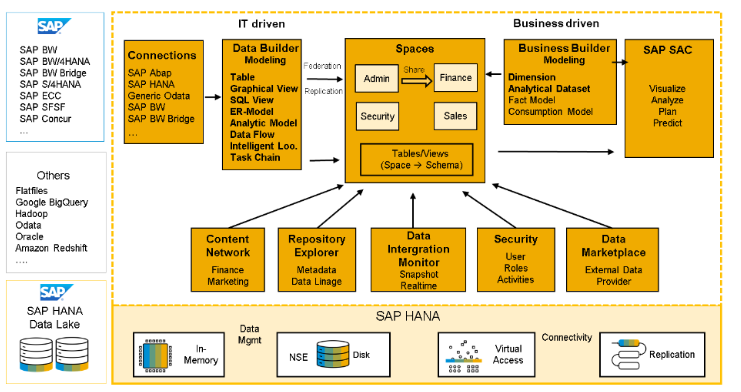
Architecture of the SAP Datasphere
What are the functionalities of SAP Datasphere?
1. Space management :
A virtual workspace in SAP Datasphere is a repository of data representing a specific business segment. The provision of workspaces makes it possible to provide centralised and secure modelling environments for different departments or use cases. Administrators can create workspaces, allocate storage space (disk and memory), define their priority, add users and assign roles to them, and use monitoring and logging tools.
2. Data integration :
SAP Datasphere enables users to import data from a wide range of sources (cloud, on-premise, SAP data, non-SAP data). Below is a list of the connection types available in SAP Datasphere :
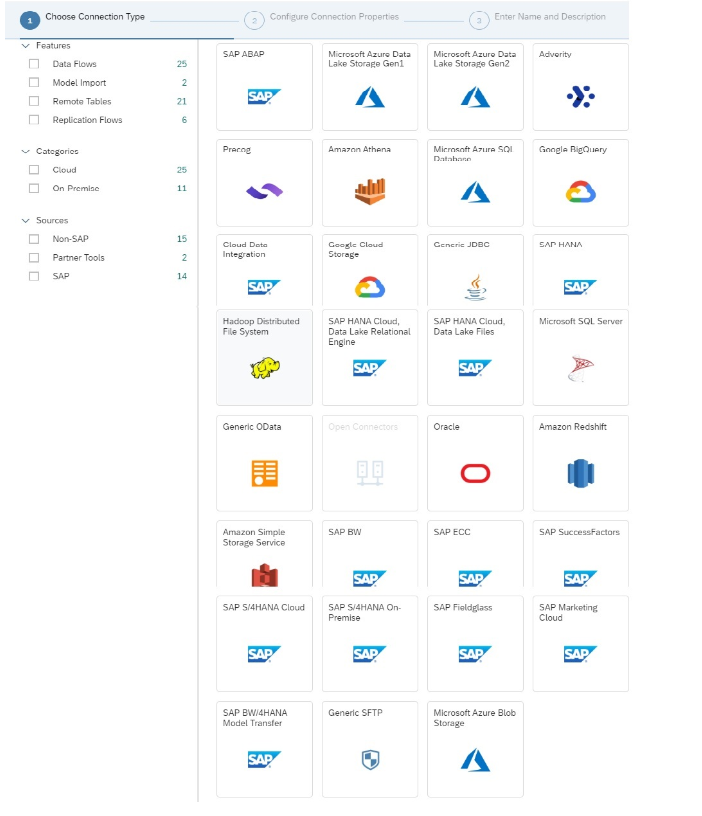
SAP Datasphere
3. Data modelling in Data Builder :
Data Builder is a modelling editor with a simplified interface. It allows you to combine, clean and prepare data for use in data restitution tools such as SAP Analytics Cloud or for modelling in Data Builder. It offers the option of importing data from CSV or CSN/JSON files.
Data Builder offers users a number of features to help them manage their data more effectively :
- Creating graphical views: enables you to create a view from one or more data sources.
- Table creation: allows you to create tables containing data by defining their structures.
- Creating relationship models: used to import, modify, view and deploy data entities (tables, views, etc.)
- Create SQL views: Allows you to create views from an SQL editor that can be used to query sources.
- Creating analytical models: enables you to create an analytical model as a basis for consumption in SAP Analytics Cloud.
- Creation of data flows: enables data to be extracted, transformed and loaded from an intuitive interface.
- Creation of replication flows: enables data to be copied from objects in the same source (CDS views, tables, ODP object) to the same target.
- Create intelligent searches: Enables data from two entities to be merged even if there is a problem with the join.
- Creation of task chains : allows you to group together several entities.
4. Data modelling in Business Builder :
Business Builder lets you combine, refine and enrich objects already created in Data Builder. It can also be used to create business units, consumption models and outlooks for use in SAC.
Business Builder allows you to :
- Create new dimensions: Allows you to create analysis axes.
- Create new fact tables: Allows you to create fact tables with measurements.
- Create a fact model : This allows you to create a model that groups together business entities of the facts and dimensions type.
- Import SAP BW/4HANA models: allows you to import analytical queries from SAP BW/4HANA.
- Creation of an authorisation scenario: used to control access to existing data. Each user has access to the relevant data according to their role.
5. SAP Datasphere Catalog :
The SAP Datasphere catalogue is a comprehensive solution that collects and organises metadata. It enables :
- Manage all system objects by providing a simplified view of data landscapes.
- Access reliable data for quality modelling.
- Data lineage and impact analysis
Metadata governance
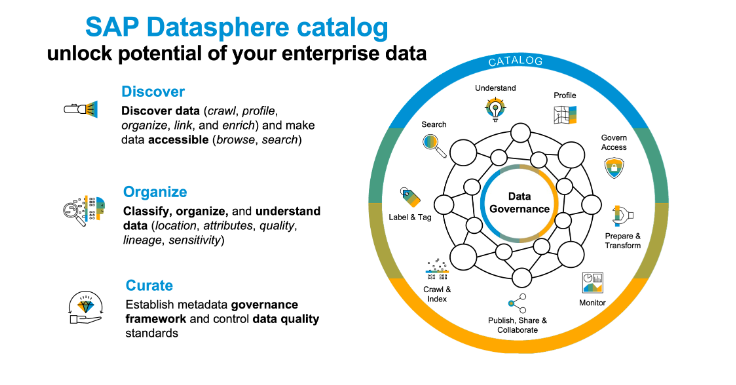
6. New strategic partnerships :
SAP has announced four strategic partnerships with data and AI companies to radically simplify its customers’ data landscapes and support the idea of integrating non-SAP data into a unified usage context.
Integrates SAP data, with its full context, with the Data Bricks Data Lakehouse platform.
Future-proof data governance, confidentiality and compliance initiative.
Puts data in motion with its data streaming platform
Puts data in motion with its data streaming platform
Conclusion
SAP Datasphere offers a powerful, comprehensive solution for companies that want to improve their data strategies. It offers an intuitive interface that makes it easy to collect, integrate and analyse data. Its ease of use, scalability and advanced analysis capabilities make it the ideal solution for organisations of all sizes that want to make the most of their data.
